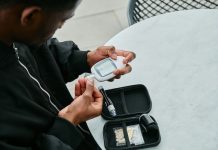
In a recent study at Australian Catholic University and elsewhere, researchers found that frequent exercise breaks during prolonged sitting may be better for blood vessel health in people with type 2 diabetes than less-frequent activity interruptions.
The study is published in the American Journal of Physiology-Heart and Circulatory Physiology.
People living with type 2 diabetes have a higher risk of heart disease and reduced vascular (blood vessel) function than those without metabolic disorder.
Measuring vascular function is often used to determine the risk of heart disease.
Increasing physical activity and decreasing the amount of time sitting—in all populations, not just those with diabetes—has been shown in previous studies to reduce the risk of heart disease.
However, with rapidly advancing technologies in workplaces, transportation, and home entertainment, fewer opportunities exist for incidental activity, creating many contexts of daily life that are conducive to prolonged sitting.
In the study, the team explored the effects of shorter, more frequent and longer, less-frequent exercise breaks on blood flow and blood vessel dilation in adults with obesity and type 2 diabetes.
Each volunteer participated in three separate trial conditions on different days. In one condition, the volunteers sat for eight hours, during which time they could read or use a phone, but they did not take activity breaks.
In a second condition, the volunteers performed three minutes of exercises that included squats, leg lifts, and calf raises every 30 minutes.
The third condition consisted of six-minute exercise breaks every hour.
The researchers found that compared with sitting, blood vessel function tended to improve throughout the day in both exercise conditions, but with much more beneficial results when the participants exercised every 30 minutes.
This suggests that the frequency of the activity break may be more important than the length of time.
The team says given that there is a progressive impairment in vascular function throughout the pathogenesis of type 2 diabetes, it is possible that more frequent interruptions to sitting are needed to preserve leg blood flow.
The new findings suggest that more-frequent and shorter breaks may be more beneficial than longer, less-frequent breaks for improvement in vascular function in those with type 2 diabetes.
Copyright © 2021 Knowridge Science Report. All rights reserved.



